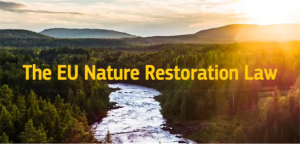Can we make better use of the Habitats Directive to achieve Nature restoration and recovery targets? – Dr Caroline Chapman FCIEEM
This blog has been written in conjunction with CIEEM’s upcoming Irish Conference: Delivering a Nature Positive Ireland.
The UK Government’s Environmental Improvement Plan and Nature Recovery Network and, for CIEEM members in Ireland, the proposed EU Nature Restoration Law means that across the British Isles considerable attention is being given to the active delivery of nature recovery. Whilst such targets, plans and ambitions are of critical importance, to secure meaningful delivery we need to recognise and prepare for the delivery challenges that will inevitably arise given the current economic and political landscape.
Having worked in the field of nature conservation for almost 30 years it is easy to become somewhat disheartened by ambitious biodiversity targets which, ultimately, are not met. The purpose of this blog is to share some thinking about how we might learn from the missed targets of the past, and to explore whether there might be opportunities to actively get ‘ahead of the curve’ by anticipating future challenges and preparing for them. In other words, given many of us can fairly confidently (if a little sceptically) predict the bumps that will be encountered along the road to nature recovery targets, can we be more proactive in identifying feasible options which might be put forward when difficulties arise?
There are various way to approach such a broad question, by way of example, one question which could helpfully be explored is: Could we make better use of the Habitats Directive in the achievement of nature restoration and recovery targets in a manner which recognises, and reacts to, current political realities and pressures?
Article 2(2) of the Habitats Directive is clear that the overarching aim of the Directive is to ‘maintain or restore’ habitats and species to a favourable conservation status. Article 2(3) emphasises the need for any measures to achieve the Directive’s objective (including those to deliver restoration) to ‘take account of economic, social and cultural requirements and regional and local characteristics’. A correct application of the Directive should always take account of such considerations, but what might this look like in practice?
Article 6 of the Habitats Directive and the four pillars of protection.
Article 6 is relevant to the network of sites designated under the Habitats and Birds Directive. Duties under Articles 6(1) and 6(2) are proactive in nature; they establish a need for conservation measures and the taking of steps to avoid deterioration and significant disturbance. Articles 6(3) and (4) are reactive provisions; they provide an effective regime of site protection which is implemented as a matter of law when transposing domestic regulations come into force. The Directive anticipates that these pillars would be implemented in parallel but, in my experience, the implementation of the proactive duties has often been neglected with the main emphasis being upon the assessment regime under Articles 6(3) and (4). There are valid reasons behind a lack of progress in delivery of Articles 6(1) and (2); the purpose of this blog is not to criticise or lament such shortfalls, but to pose the question as to whether a shift in focus away from proactive measures has led to unintended consequences. Have we overlooked potential benefits that might arise from active engagement with Articles 6(1) and (2) and the extent to which they might facilitate the delivery of plans and projects under Article 6(3) and the wider achievement of restoration duties and future recovery targets?
Unintended consequences when Article 6(3) operates in isolation…
Article 6(3) provides for a strict step-wise assessment process for new plans and projects. Where a site has a restoration objective, problems can arise with the application of Article 6(3) in isolation. A degree of overlap can arise between measures that are suitable as mitigation for the effects of new plans and projects and measures which might be involved in delivering restoration (avoiding deterioration) from existing activities/sources. In the absence of parallel initiatives to deliver management and restoration duties the delivery of mitigation for new plans and projects can have unintended consequences in compromising the achievement of restoration duties. In other words, measures which might otherwise be available to deliver restoration and nature recovery are traded off against growth. This risk to nature recovery increases where the suite of effective mitigation/ restoration measures is limited.
The operation of Article 6(3) in isolation of parallel initiative under Articles 6(1) and (2) can therefore hinder the delivery of improvement and restoration initiatives. On the flipside, the delivery of restoration serves to facilitate growth by creating environmental capacity for new plans and projects.
Opportunities for a coordinated strategic approach to the delivery of duties under the Habitats Directive
If risks to the delivery of nature recovery targets can reasonably be anticipated from a shortfall in the delivery of duties under Article 6(1) and (2), can anything be done to avoid or minimise that risk? There are various options as to how this might be achieved, but any feasible option must recognise the resource constraints facing statutory bodies in delivering restoration and recovery duties.
Simply highlighting the benefits of nature restoration may not be sufficient to secure the necessary resources for delivery. One option which perhaps warrants further consideration, with a view to delivering restoration whilst taking account of wider economic and social requirements (as envisaged under Article 2(3)), is the potential for a coordinated strategic approach to the delivery of site management, mitigation and restoration under the Habitats Directive. Such an approach could deliver duties under Articles 6(1), (2) and (3) in a parallel manner, ensuring recovery targets are not compromised by the delivery of plans and projects. Such an approach may provide opportunities to maximise nature recovery outcomes whilst delivering mitigation to facilitate growth.
Various practical issues will need to be addressed in implementation of any such approach, but with sufficient political will, opportunities to co-ordinate the exercise of statutory powers do, in my opinion, exist. In principle, and where relevant, any such approach could also be extended to cover the delivery of compensatory measures under Article 6(4).
In order to be effective caution will be needed to ensure that the primary aim of a coordinated approach is the delivery of nature recovery. Any mitigation benefits would need to demonstrate that the wider objective of recovery is not undermined. The exercise of statutory powers may also be necessary to ensure the targeted delivery of measures whilst securing the best ecological outcomes.
Dr Caroline Chapman from DTA Ecology will be speaking about this more at our upcoming Irish Conference: Delivering a Nature Positive Ireland
Blog posts on the CIEEM website are the views and opinions of the author(s) credited. They do not necessarily represent the views or position of CIEEM. The CIEEM blog is intended to be a space in which we publish thought-provoking and discussion-stimulating articles. If you’d like to write a blog sharing your own experiences or views, we’d love to hear from you at SophieLowe@cieem.net.

